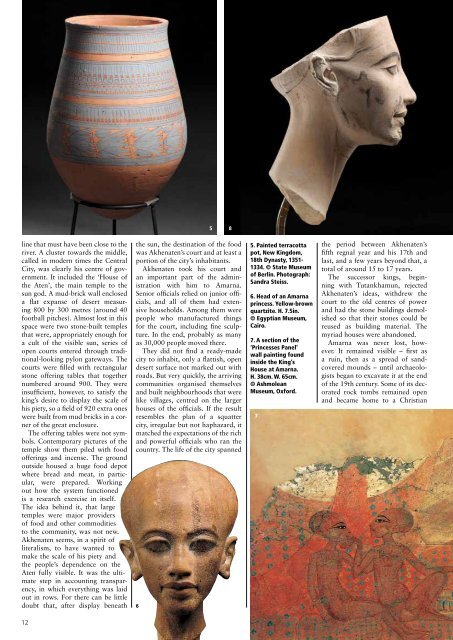Following Odysseus Not the end of the world Amarna city of light ...
Following Odysseus Not the end of the world Amarna city of light ...
Following Odysseus Not the end of the world Amarna city of light ...
- No tags were found...
Create successful ePaper yourself
Turn your PDF publications into a flip-book with our unique Google optimized e-Paper software.
5 8line that must have been close to <strong>the</strong>river. A cluster towards <strong>the</strong> middle,called in modern times <strong>the</strong> CentralCity, was clearly his centre <strong>of</strong> government.It included <strong>the</strong> ‘House <strong>of</strong><strong>the</strong> Aten’, <strong>the</strong> main temple to <strong>the</strong>sun god. A mud-brick wall encloseda flat expanse <strong>of</strong> desert measuring800 by 300 metres (around 40football pitches). Almost lost in thisspace were two stone-built templesthat were, appropriately enough fora cult <strong>of</strong> <strong>the</strong> visible sun, series <strong>of</strong>open courts entered through traditional-lookingpylon gateways. Thecourts were filled with rectangularstone <strong>of</strong>fering tables that toge<strong>the</strong>rnumbered around 900. They wereinsufficient, however, to satisfy <strong>the</strong>king’s desire to display <strong>the</strong> scale <strong>of</strong>his piety, so a field <strong>of</strong> 920 extra oneswere built from mud bricks in a corner<strong>of</strong> <strong>the</strong> great enclosure.The <strong>of</strong>fering tables were not symbols.Contemporary pictures <strong>of</strong> <strong>the</strong>temple show <strong>the</strong>m piled with food<strong>of</strong>ferings and incense. The groundoutside housed a huge food depotwhere bread and meat, in particular,were prepared. Workingout how <strong>the</strong> system functionedis a research exercise in itself.The idea behind it, that largetemples were major providers<strong>of</strong> food and o<strong>the</strong>r commoditiesto <strong>the</strong> community, was not new.Akhenaten seems, in a spirit <strong>of</strong>literalism, to have wanted tomake <strong>the</strong> scale <strong>of</strong> his piety and<strong>the</strong> people’s dep<strong>end</strong>ence on <strong>the</strong>Aten fully visible. It was <strong>the</strong> ultimatestep in accounting transparency,in which everything was laidout in rows. For <strong>the</strong>re can be littledoubt that, after display beneath<strong>the</strong> sun, <strong>the</strong> destination <strong>of</strong> <strong>the</strong> foodwas Akhenaten’s court and at least aportion <strong>of</strong> <strong>the</strong> <strong>city</strong>’s inhabitants.Akhenaten took his court andan important part <strong>of</strong> <strong>the</strong> administrationwith him to <strong>Amarna</strong>.Senior <strong>of</strong>ficials relied on junior <strong>of</strong>ficials,and all <strong>of</strong> <strong>the</strong>m had extensivehouseholds. Among <strong>the</strong>m werepeople who manufactured thingsfor <strong>the</strong> court, including fine sculpture.In <strong>the</strong> <strong>end</strong>, probably as manyas 30,000 people moved <strong>the</strong>re.They did not find a ready-made<strong>city</strong> to inhabit, only a flattish, op<strong>end</strong>esert surface not marked out withroads. But very quickly, <strong>the</strong> arrivingcommunities organised <strong>the</strong>mselvesand built neighbourhoods that werelike villages, centred on <strong>the</strong> largerhouses <strong>of</strong> <strong>the</strong> <strong>of</strong>ficials. If <strong>the</strong> resultresembles <strong>the</strong> plan <strong>of</strong> a squatter<strong>city</strong>, irregular but not haphazard, itmatched <strong>the</strong> expectations <strong>of</strong> <strong>the</strong> richand powerful <strong>of</strong>ficials who ran <strong>the</strong>country. The life <strong>of</strong> <strong>the</strong> <strong>city</strong> spanned65. Painted terracottapot, New Kingdom,18th Dynasty, 1351-1334. © State Museum<strong>of</strong> Berlin. Photograph:Sandra Steiss.6. Head <strong>of</strong> an <strong>Amarna</strong>princess. Yellow-brownquartzite. H. 7.5in.© Egyptian Museum,Cairo.7. A section <strong>of</strong> <strong>the</strong>‘Princesses Panel’wall painting foundinside <strong>the</strong> King’sHouse at <strong>Amarna</strong>.H. 38cm. W. 65cm.© AshmoleanMuseum, Oxford.7<strong>the</strong> period between Akhenaten’sfifth regnal year and his 17th andlast, and a few years beyond that, atotal <strong>of</strong> around 15 to 17 years.The successor kings, beginningwith Tutankhamun, rejectedAkhenaten’s ideas, withdrew <strong>the</strong>court to <strong>the</strong> old centres <strong>of</strong> powerand had <strong>the</strong> stone buildings demolishedso that <strong>the</strong>ir stones could bereused as building material. Themyriad houses were abandoned.<strong>Amarna</strong> was never lost, however.It remained visible – first asa ruin, <strong>the</strong>n as a spread <strong>of</strong> sandcoveredmounds – until archaeologistsbegan to excavate it at <strong>the</strong> <strong>end</strong><strong>of</strong> <strong>the</strong> 19th century. Some <strong>of</strong> its decoratedrock tombs remained openand became home to a Christian12
















